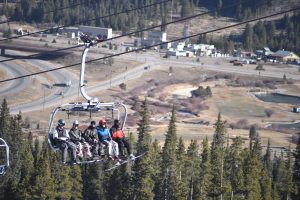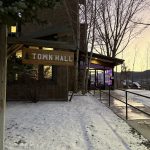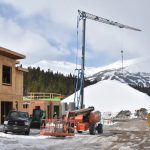Climbing lodging prices among Colorado’s ski resorts deter some winter tourists
Early booking data shows that as fewer visitors are booking rooms in Colorado's ski resorts past the holidays, a likely consequence of rising room prices, lackluster snowfall and economic uncertainty.

Kyle McCabe/Summit Daily News
Summer may have ended on a positive note for Colorado’s mountain towns, but the optimism is already giving way to winter uncertainty as visitors push back against rising room rates and post-holiday bookings lag behind last year.
Colorado’s mountain resorts wrapped up the 2025 summer tourism season in better shape than they started, with moderate gains in occupancy, rates and seasonal revenue, according to Inntopia’s most recent monthly Market Briefing from DestiMetrics.
The report includes data from approximately 28,000 lodging units (including some booked through sites like Airbnb and Vrbo) across seven states — Colorado, Utah, California, Nevada, Wyoming, Montana and Idaho. Colorado’s resorts are the dominant data set, making up 39% of the lodging units weighed in Inntopia’s resort market data.
The turn of the season leaves no breathing room for summer’s successful season, with lodging experts expressing “cautious optimism” about the upcoming winter season thanks to a dropoff in post-holiday bookings.
Whether the upcoming winter season follows up on past successes depends largely on two fluctuating variables: Mother Nature and the economy.
Summer bookings end on a positive note
At the start of Colorado’s summer tourism season, resort towns were reporting drops in bookings and occupancy as mountain resorts raised prices, international tourism slipped, tariffs raised anxiety about the economy and summer drought conditions worsened wildfire risk.
Even still, October’s official end to the summer season managed to bring in positive revenue for rural mountain resorts. The average revenue for Inntopia’s markets grew by 3.8% for the season, beating the most recent annual inflation rate. Meanwhile, occupancy concluded with a 1.1% year-over-year increase and daily rates went up 2.7%.
Winter visitors push back against higher room prices
Last year’s winter season, despite starting strong in 2024, ended with softer visitation numbers than Colorado travel experts had hoped. It’s a picture not too unfamiliar to the one early-season outlooks show could happen again.
Holiday occupancy across all seven states is looking strong heading into Thanksgiving and Christmas as of Oct. 31, according to the report. The Thanksgiving holiday period from Nov. 21 to Dec. 5 is up 1.6%, with Thanksgiving Day up a healthy 7.4% compared to last year.
Where occupancy outlook starts to soften, however, is after Christmas and into early January.
“From a real concern point of view, people are feeling okay, but not confident about how demand is going to look this year,” said Tom Foley, senior vice president of Business Intelligence for Inntopia and author of the market briefing report. “There’s a significant percentage of them that are actually not feeling confident at all about how demand is going to look.”
Despite demand for rooms being lower than it was last year, revenue is still projected to increase for western mountain resorts, helping to cushion against some of the industry’s uncertainty.
Foley said one of the reasons behind this switch is higher per-night room prices, as resorts increasingly target visitors willing to spend more money and shift their attention away from the higher number spending at a lower price point — a strategy that seems to be paying off for now.
The average daily rate across all seven states is up 2.7% for the full winter season, Foley said, for an aggregated price of $688 per night.
In comparison, the average daily rate for lodging units in Colorado is up 2.1% from last winter, to $712 per night, and is projected to increase as winter progresses.
“(Resorts) have the same or fewer people coming to their properties, but those that are coming are very high quality bookings that are actually driving up the bottom line,” Foley said. “Properties have found, at least at this early stage, that they can ask a bit more for rates and sacrifice some of that occupancy as long as the gain is larger than the decline.”
An important distinction is that lower occupancy doesn’t always translate to fewer visitors — sometimes it signals that a larger group of people is booking for fewer days.
Bookings made in October for arrival in that month were down compared to last year, as “many consumers pushed back against what turned out to be stronger-than-expected room rates,” Foley wrote. The results were fewer reservations paired with higher revenue from higher-spending visitors, which contributed to bolstering the bottom line to deliver a season-high 5.4% increase in revenues for the month across Inntopia’s markets.
October’s flat booking pace, along with a mixed booking pace and changes in available inventory, are partially responsible for holding back winter’s occupancy growth, which poses a weaker outlook from November through April as of Oct. 31 compared to what resorts were reporting at the end of September.
Among Colorado’s over 10,000 lodging units tracked by Inntopia, occupancy for those six months is 3% lower than last winter, compared to a 0.4% drop for the overall resort industry.
Month-by-month results are a little more nuanced: bookings for arrivals in October, January, and February slipped down compared to last year, while November, December, and March all reported gains (November reported a 12.8% increase across all seven states).
Additionally, there are approximately 24,000 fewer room nights available for rent this year than last across Inntopia’s resort markets, an inventory deficit that continues summer trends. Foley said these inventory shifts are common in mountain communities because a significant percentage of rooms are privately owned, leading to higher owner usage.
Inntopia’s outlook for the second half of Colorado’s winter season might not look the same in a few months, however, as several factors can change between now and the Christmas season. Foley said that although the industry is booked at roughly 31% occupancy for the season, only half of the total nights have been booked so far.
“The real trend stuff doesn’t show up until November-December,” Foley said.
Consumer confidence, international tourism dwindles
Resorts aren’t the only businesses impacted by waning numbers of visitors or tourist spending. Foley said past lodging studies have indicated that as lodging properties get more expensive, local businesses on Main Street see fewer dollars.
“When rate goes up, spending on Main Street can be impacted as people have fewer discretionary dollars in their pockets,” Foley said.
What doesn’t impact occupancy and spending as much as people would think, he added, is climbing lodging taxes.
Foley said Inntopia conducted studies, at the request of specific mountain towns, comparing the relationship between lodging taxes and tourism rates to resort towns. Those studies found the impact on the bottom line is generally positive.
“There can be a negative pushback that dissipates after 12 months or so, and looks better as we look (two, three years) in the rear-view mirror,” he said. “In different towns, we see that there is, in about 50% of cases, some version of a shock event that hits visitation and revenue, but it does not last. And that is largely because these towns are not doing things all at the same time.”
Another factor shortening vacations is inflation.
The national inflation rate increased in September, with prices up 0.3% from August, and inflation is now up 3% year-over-year, according to the report. Prices for gasoline were up 4.1%, while airfare prices climbed by 2.7%.
“Increases in those categories add pressure to consumers planning travel for the upcoming winter season,” Foley wrote, adding that both the Consumer Confidence Index and the Consumer Sentiment Index slipped in October.
International visitation to Colorado resort towns is still down, particularly from Canada, though things have improved since the summer.
Bookings from Canada to resorts in the northwest are down almost 53% year-over-year and have remained at a similar level for six months, despite being the largest source of international visitors. Bookings from Mexico are up 35%, Western Europe is up 9.6%, and Australia and New Zealand are down 28.4%.
But if there’s one thing that can revive hope for winter bookings, experts say, it’s snow.
“While some resorts have already opened, we are well aware that economic indicators, inflationary pressures and political mayhem are contributing to ongoing consumer caution about discretionary spending, so we’ll look for some bounty from Mother Nature to spark more booking activity in the weeks ahead,” Foley wrote.

Support Local Journalism

Support Local Journalism
As a Summit Daily News reader, you make our work possible.
Summit Daily is embarking on a multiyear project to digitize its archives going back to 1989 and make them available to the public in partnership with the Colorado Historic Newspapers Collection. The full project is expected to cost about $165,000. All donations made in 2023 will go directly toward this project.
Every contribution, no matter the size, will make a difference.









